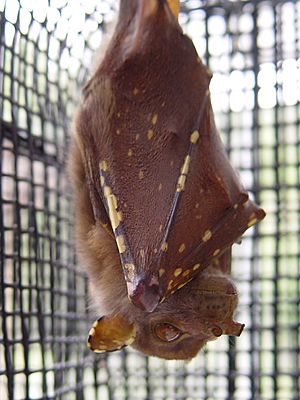Eastern tube-nosed bat facts for kids
Quick facts for kids Eastern tube-nosed bat |
|
|---|---|
 |
|
| An individual in care at the Tolga bat hospital. | |
| Conservation status | |
| Scientific classification | |
| Genus: |
Nyctimene
|
| Species: |
robinsoni
|
 |
|
| Eastern tube-nosed bat range | |
The eastern or Queensland tube-nosed bat (Nyctimene robinsoni) is a type of megabat, also known as a fruit bat. It lives in north-eastern Australia. This bat is special because it usually sleeps alone, unlike many other fruit bats. It gets its name from its unique nostrils, which stick out like little tubes. These bats are deep brown with gray heads and have a few yellow spots.
Contents
Discovering the Eastern Tube-Nosed Bat
The Eastern tube-nosed bat was first described by a scientist named Oldfield Thomas in 1904. He noticed it was different from other bats he had studied. Thomas looked at two bats, which were found by Herbert C. Robinson in a place called Cooktown, Queensland.
This bat is also known as the Queensland tube-nosed bat. The name "eastern tube-nosed bat" was later used by places like the Australian Museum.
What Does It Look Like?
The Eastern tube-nosed bat is the only Nyctimene bat found on mainland Australia. You can easily spot it because of its unusual nostrils that stick out from its short, rounded nose. Its ears and wing membranes have many small, bright yellow or yellow-green spots.
Its fur is reddish-brown to grayish-brown, with the face and head being grayer. There's also a dark line running down its back from its neck. When light shines on their eyes, they look bright red!
These bats are about 8 to 9 centimeters long from head to body. Their forearms (the main bone in their wing) are about 6.5 to 7 centimeters long. Their ears are about 1.6 to 2 centimeters long. On average, they weigh about 48 grams, which is about the same as a small apple.
Their teeth are perfect for eating fruit. They don't have lower front teeth, but they use their lower canine teeth against their upper ones to chew fruits. When they fly, they make a high-pitched "seep" sound.
Where Do They Live?
These bats live along the east coast of Australia, from Lismore, New South Wales all the way up to Cape York. You can also find them on the islands of the Torres Strait. They are quite common in Queensland, but you see them less often south of Ingham.
Their homes include rainforests, woodlands, and heathlands. They prefer tropical and subtropical areas, especially wet forests or places with lots of trees and shrubs.
How Do They Behave?
Like other fruit bats, the Eastern tube-nosed bat uses its excellent eyesight and sense of smell to find food. They mostly eat figs and other fruits found in rainforests. They also enjoy flowers, nectar, and pollen. Sometimes, they even eat cultivated fruits like guava.
They seem to prefer native Australian fruits over fruits from orchards. They don't usually fly far to find food, often sticking to trees like the Ficus racemosa. This bat is one of 14 tube-nosed bat species in the world, and it lives the furthest south.
Female bats usually have one baby per year, born between October and December. The mother carries her baby until it's big and strong. Pregnancy lasts about three to three and a half months.
Scientists think the bat's tube-shaped nostrils help it find ripe fruit. Each nostril can move on its own, which might help them sniff out fruit smells in the rainforest. This is like having "stereo smell"! People once thought these nostrils acted like snorkels, helping them breathe while their mouths were buried in soft fruits. However, this idea was proven wrong because they mostly eat firm fruits and bite and lick them, just like most other fruit bats.
These bats are very good at flying and can even hover while looking for food. You might see them flying along forest paths, sometimes quite low to the ground, and hear their whistling calls.
They usually roost (sleep) alone, which is unusual for fruit bats. Sometimes, they might be seen in small groups. When they sleep during the day, they wrap their spotted wings around their bodies and hang alone in thick leaves. This helps them blend in with the dappled sunlight in the forest, making them hard to spot.
Eastern tube-nosed bats seem to be less active on nights with a full moon. This might be because fruit is easier to see on bright nights, so they don't need to fly as much. Or, it could be that they are trying to avoid predators who can see them better on bright nights.
When kept in captivity, they can eat pears, bananas, pawpaw, and citrus fruits. They don't seem to drink water.
Protecting the Eastern Tube-Nosed Bat
The Eastern tube-nosed bat is considered "least concern" in Queensland, where it's more common. However, in New South Wales, it's listed as "vulnerable," meaning it needs more protection.
These bats are especially at risk from barbed wire fences. Many bats get tangled in the wire, which can be deadly. After a big storm called Cyclone Larry in 2006, sixteen bats were found caught in barbed wire fences in the Atherton Tableland. They can also get caught in netting that farmers put over fruit trees, which can lead to them starving.
The Eastern tube-nosed bat plays a very important role in its habitat. When they eat fruit, they help pollinate plants and spread seeds. This helps new trees grow and keeps the forest healthy.
See also
 In Spanish: Nyctimene robinsoni para niños
In Spanish: Nyctimene robinsoni para niños


